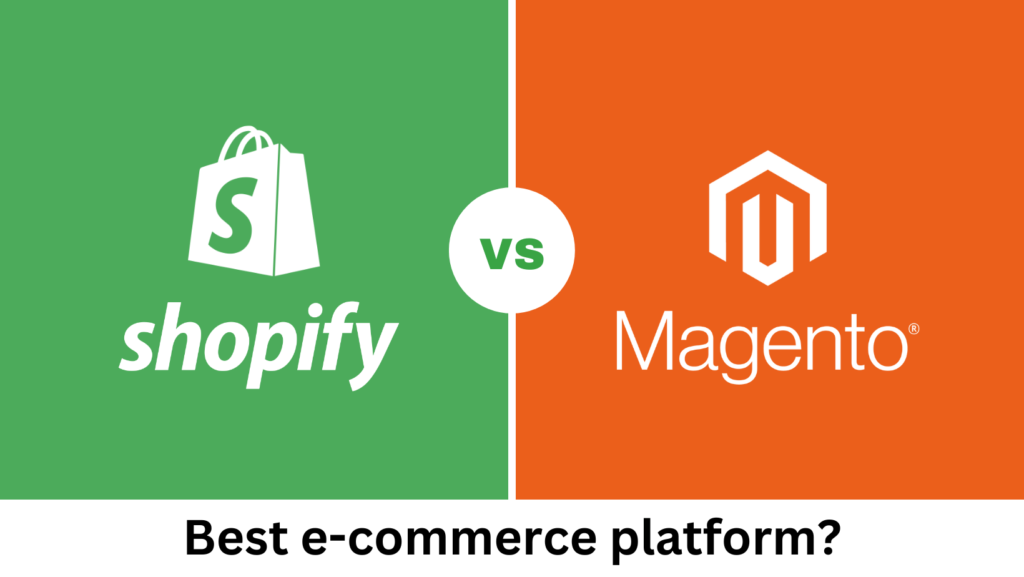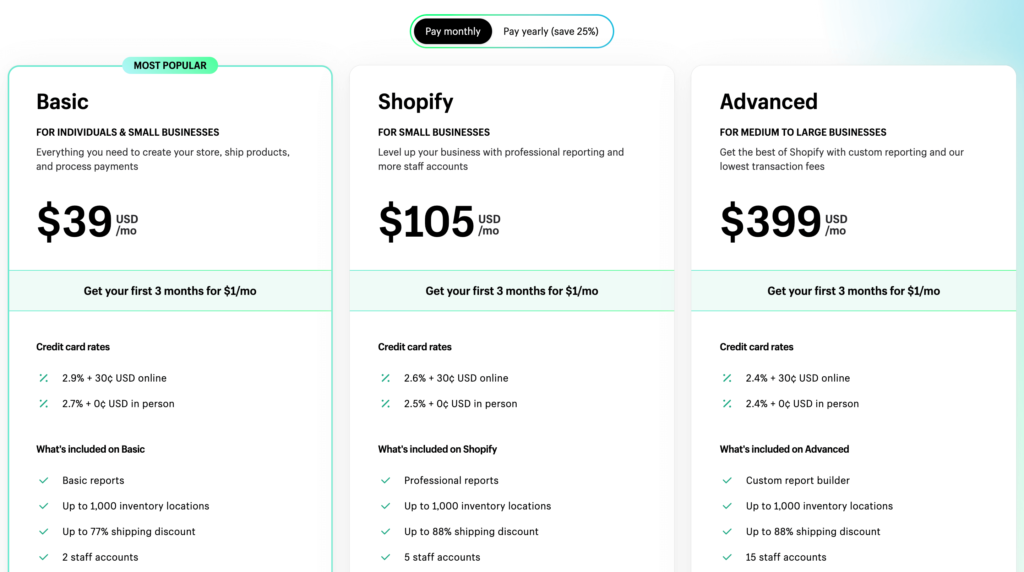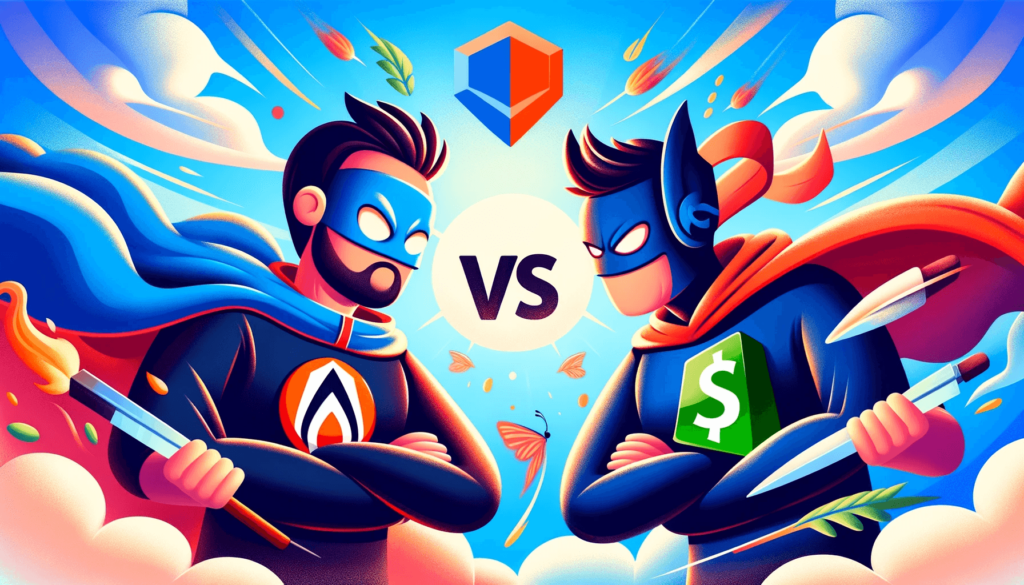Hello there, fellow entrepreneurs and dreamers! Today we’re tackling the big question: Shopify vs Magento – which one is the best for you?
If you’re stepping into the vibrant world of e-commerce, you’re probably feeling a mix of excitement and, let’s be honest, a bit of confusion.
Choosing the right e-commerce platform is like picking a partner for a dance competition – it can make or break your performance!
Imagine this: You’ve got a brilliant idea for an online store. Your head is buzzing with product ideas, marketing plans, and dreams of success.
But then, you hit a roadblock – which platform do you choose to turn these dreams into reality?
With so many options out there, it can feel like trying to find a needle in a digital haystack.

Don’t worry; I’ve been there.
And that’s why I’m here to guide you through this maze.
Together, we’ll explore the ups and downs, ins and outs of Shopify and Magento. We’ll look at them from all angles – costs, ease of use, flexibility, and more.
By the end of this article, you’ll have a clear picture of which platform dances to the rhythm of your business goals.
So, let’s lace up our dancing shoes and dive into the world of Shopify and Magento!
Shopify vs Magento: In a nutshell
Let’s put Shopify and Magento side by side to see how they stack up against each other in key areas.
This quick-glance table will help you weigh your options more effectively. 👇
| Criteria | Magento | Shopify |
|---|---|---|
| Web Hosting | Not included; requires third-party hosting. | Included with all plans. |
| User Experience | Offers ease with ready-made extensions, user-friendly admin panel. Requires more technical skill. | Known for its ease of use with drag-and-drop store builder, suitable for beginners. |
| Speed | Magento 2 performs faster than its previous version, but speed can depend on hosting. | Generally faster than Magento, better for site speed and SEO. |
| Checkout | Excellent checkout experience with various out-of-the-box features. | Responsive one-page checkout, but real-time shipping rates not available for lower-tier plans. |
| Coding | Open-source with PHP; free modification of the source code. Requires coding knowledge. | Uses proprietary Liquid coding, more suitable for simpler stores and less complex customizations. |
| Themes and Templates | Larger collection of both free and paid themes. Custom themes can be expensive. | Over 100 themes including free options; more contemporary and user-friendly. |
| Market Share | Strong presence, especially in larger, complex e-commerce sites. | Popular among a wide range of businesses, including high-profile clients. |
| Expense | Open-source and free, but hosting, themes, and extensions are additional costs. | Subscription-based with different plans; additional costs for apps and certain features. |
| Apps and Add-Ons | Over 5,000 options (mix of paid and free), more technical to integrate. | Over 8,000 apps, both free and premium, easier to use and integrate. |
| Multilingual Support | More built-in multilingual support. | Requires third-party/paid apps for full multilingual capabilities. |
| SEO | Strong SEO capabilities, but may require technical skill to fully utilize. | Strong SEO capabilities with user-friendly tools. |
| Payment Gateway | Supports over 100 payment gateways; third-party add-ons may be needed for some. | Supports over 70 payment gateways; no transaction fees for using Shopify’s gateway, fees for other gateways. |
| Pricing | Community Edition: Free, Hosting: $4-$100+/month | Basic: $29/month, Pro: $79/month, Unlimited: $179/month |
| Sales Features | Advanced inventory system, bulk product import, various sales tools through extensions. | Impressive range of built-in sales tools like multi-channel selling and abandoned cart recovery. |
| Marketing Tools | Extensive tools available through Marketplace; often requires developer for integration. | Built-in marketing tools, including email campaigns and social media advertising. |
| Support | Community support, forums, developer documentation. Professional support may incur costs. | 24/7 support available, along with help docs, webinars, blog posts, and online courses. |
Pros and Cons: Shopify vs Magento
Embarking on the e-commerce journey is like setting sail in the vast ocean of online retail. And the first big wave you encounter? Deciding between Shopify and Magento.
Let’s break down the pros and cons of each to help you navigate these waters.
👍 Pros of Shopify
- Smooth Sailing: Shopify’s user-friendly interface is perfect for beginners and those who prefer a hassle-free setup.
- Design Haven: An array of stunning themes make your store look professional with minimal effort.
- Always On Deck: 24/7 support is always there to assist you, anytime, day or night.
👎 Cons of Shopify
- Costs on the Horizon: Be aware of extra costs, including transaction fees for external payment gateways and costs for certain apps and themes.
- Limitations in Customization: Shopify offers limited options for deep customization without coding expertise.

👍 Pros of Magento
- Customization Galore: Ideal for those with coding knowledge or access to a developer, offering vast customization options.
- A Strong Fleet: A vast and knowledgeable community offering support and extensions to enhance your store.
👎 Cons of Magento
- Navigational Challenges: Setting up Magento can be complex, requiring more technical expertise.
- Additional Supplies: While free to download, budget for hosting, themes, and add-ons.
- Steep Learning Curve: Its flexibility comes with complexity, potentially daunting for beginners.
So, which platform will you pick for your e-commerce journey? The easy-to-use and stylish Shopify, or the highly customizable and strong Magento?
In the next parts of this article, we’ll look closer at each platform. Think about which features are the best fit for your business and your own skills.
Detailed Feature Comparison: Shopify and Magento

Choosing between Shopify and Magento isn’t just about the pros and cons. It’s also about the different features they offer.
Let’s take a closer look at some key features to help you understand what each platform brings to your online store.
Order and Inventory Management
When it comes to managing products, both Shopify and Magento shine, but in different ways. Shopify is a breeze for beginners. It lets you add and sell an unlimited number of products and integrates directly with tools like Oberlo for dropshipping.

Magento, while also allowing unlimited products, requires a bit more tech know-how. You might need to optimize server performance and site speed as your store expands.
Shipping Charges Calculation
Figuring out shipping charges is a crucial part of selling physical goods. Shopify simplifies this with flexible options and specialized apps for accurate shipping calculations.
Keep in mind, depending on your business model, you may not even utilize Shopify shipping carriers. For instance, a dropshipping agent will often buy shipping labels for the merchant instead of the other way around.
Magento also offers robust shipping options, but they might require more technical setup to get right. For more details on Shopify’s shipping tools, check out their shipping page.

Coupons and Discount Codes
Discounts are a fantastic way to attract customers. Magento is great here, allowing easy creation and management of discount codes.
Shopify supports discounts too, but not on its Lite plan, so consider this when choosing your plan. This article from Aitoc explains pretty well how to set up Magento discounts.
Payment Gateway Options
Shopify supports over 70 payment gateways, giving you a wide range of options. However, using a gateway other than Shopify’s own can incur transaction fees.
Magento offers fewer native gateways but allows more flexibility with third-party add-ons. This flexibility can be crucial depending on your specific payment needs.
Themes and Customization
Your store’s look and feel are important. Shopify offers a range of themes that are easy to use and customize without needing to know how to code.
Magento, with its open-source nature, provides a broader scope for customization but often requires technical expertise or a developer.

SEO and Marketing Tools
Getting your store seen by customers is key. Both Shopify and Magento offer strong SEO features to help your store rank well in search results.
When it comes to marketing tools, Shopify provides various built-in options, while Magento often relies on third-party extensions for advanced marketing features.
User Experience and Support
A platform’s ease of use can significantly impact your daily operations. Shopify is known for its user-friendly interface and excellent customer support, available 24/7.

Magento, while offering a flexible platform, has a steeper learning curve and its support varies depending on the edition and the community resources you access.
Hosting and Security
Shopify is a hosted platform, meaning hosting is included in their plans, which simplifies things a lot. Magento, being self-hosted, requires you to find and manage your hosting, which adds an extra layer of responsibility but gives you more control.
Hostinger is an excellent choice for new website owners offering economical pricing plans and can accommodate 100 websites. It comes with a free domain for 12 months, insane support, and in-house CDN, making it easier to create WordPress websites!
Community and Resources
Both platforms have strong communities. Shopify’s community includes a wide range of users, from beginners to experts, offering diverse insights.
Magento’s community is technically robust, ideal for those who need advanced technical help or custom solutions.
Cost Implications
Finally, cost is a significant factor.
Shopify’s pricing is straightforward with its monthly plans, but remember to factor in additional costs for apps and premium themes.

Magento’s Community Edition is free, but hosting costs, developer fees, and add-ons can add up.
There’s a lot to consider when comparing Shopify and Magento. Each platform has its strengths and can be the perfect fit depending on your business needs, technical skills, and budget.
For an even deeper dive, visit Shopify and Magento to explore further.
Technical Aspects and User Experience of Shopify and Magento

Now, let’s talk about the tech stuff and how easy these platforms are to use.
Don’t worry, I’ll keep it simple!
Shopify: Easy as Pie
Think of Shopify like a modern smartphone – it’s designed to be easy for anyone to use. You don’t need to be a tech wizard to set up your store. It’s all about drag-and-drop here, making your life super easy. Plus, Shopify takes care of all the technical bits like web hosting and security, so you don’t have to worry about them.
Magento: More Hands-On
Magento is more like building a custom computer. It’s powerful and flexible, but you need some tech skills to get the most out of it. You’ll handle hosting yourself, which means you have more control but also more responsibility. It’s great if you want to get your hands dirty in tech, but it can be a bit much for beginners.
SEO and Marketing
Getting your store noticed by customers is super important. Both Shopify and Magento are pretty good at this. They have tools to help your store show up in search engines like Google. Shopify keeps it simple, while Magento offers more advanced tools – but they might take more time to learn.
Design and Customization
Your store’s design is like its outfit – it needs to look good! Shopify has lots of beautiful themes that are easy to tweak, even if you’re not a designer. Magento also offers themes, but it really shines if you know a bit about coding or if you’re willing to hire someone who does.
So, what’s it going to be? The straightforward, easy-to-use Shopify or the more technical, customizable Magento?
Your choice depends on how comfortable you are with technology and how unique you want your store to be.
Cost Analysis and Final Recommendations: Shopify vs Magento

When it comes to choosing an e-commerce platform, the “Shopify vs Magento” debate often boils down to cost. What will each platform cost you, and what value do they bring to your business?
Let’s break down the costs in detail and conclude with some final recommendations.
Shopify: A Transparent Cost Structure
Shopify is known for its clear and predictable pricing, making it a go-to choice for many new entrepreneurs.
Here’s a breakdown:
- Basic Shopify: $29/month – Ideal for small businesses starting out. Includes all the basics for setting up a shop.
- Shopify: $79/month – Best for growing businesses with 2-5 staff accounts. Offers more features like professional reports and lower credit card rates.
- Advanced Shopify: $299/month – Suited for scaling businesses that require advanced reporting.
- Shopify Plus: Starts around $2,000/month – Tailored for high-volume merchants and big businesses, offering advanced features and support.
- Additional Costs: Add-ons for themes, apps, and transaction fees for using payment gateways other than Shopify Payments.
With Shopify, what you see is mostly what you get in terms of pricing. The costs are upfront, making budgeting easier for business owners. It’s a great option if you value simplicity and predictability in expenses.
Magento: More Than Meets the Eye
Magento, with its open-source edition, might seem free at first glance, but it has its share of additional costs.
Here’s what you need to consider:
- Magento Open Source: Free to download, but you need to pay for hosting, domain, and security.
- Hosting: Varies based on provider, starting around $10/month for basic shared hosting to $100+/month for dedicated servers.
- Themes and Extensions: Free and paid options are available, with premium themes costing from $50 to $200 and extensions varying widely in price.
- Developer Costs: If you’re not tech-savvy, hiring a developer can add significantly to your costs, often ranging from a few hundred to thousands of dollars.
- Magento Commerce: Tailored for large businesses, pricing is custom and typically starts in the thousands.
Magento’s open-source platform offers flexibility and customization, but it can be costly, especially when considering development and maintenance costs. It’s ideal for businesses that need a highly customizable platform and have the budget for it.
Shopify vs Magento: Picking the Right Platform for Your Business
Deciding between Shopify and Magento involves understanding not just the immediate costs, but also the long-term value each platform brings to your business. Here are some final thoughts to consider:
- For Startups and Small Businesses: Shopify is often the more practical choice. Its straightforward pricing and user-friendly interface make it ideal for those just starting out.
- For Businesses with Custom Needs: Magento is better suited for businesses that require extensive customization and have the resources for ongoing maintenance and development.
- Consider Your Growth Trajectory: Think about where you see your business in a few years. Shopify is great for quick scaling, while Magento offers more control for custom growth.
In the Shopify vs Magento comparison, Shopify appeals with its ease of use and clear pricing, while Magento stands out for its customization capabilities and flexibility, albeit with higher potential costs. Your choice should align with your business’s current needs, technical abilities, and growth plans.
Wrapping Up: Shopify or Magento, Which is Your Winner?
Alright, we’ve talked a lot about Shopify vs Magento. Now, it’s time to wrap things up! Choosing the right one can be a big decision, but I hope this article made it a bit easier for you.
If you’re just starting out or you like things simple and straight, Shopify is like your friendly neighborhood store. It’s easy to use, you get lots of help, and you know exactly what you’re paying for each month. It’s great if you want to open your shop quickly and without much fuss.
Now, if you’re someone who loves to tinker and customize every little detail, Magento might be your game. It’s like having a big box of Lego bricks – you can build almost anything you can imagine. But remember, it can be a bit tricky to use and might cost more, especially if you need to hire someone to help.
In the end, it’s all about what works best for you and your store. Do you want the easy and helpful Shopify, or the super-customizable Magento?
Think about what you need, what you can spend, and how tech-savvy you are. Then go for the one that feels right for your business adventure.
Thanks for hanging out with me in this Shopify vs Magento showdown. I’m cheering for you and your business to do awesome things! If you’ve got more questions or need a bit more advice, just give me a shout. Here’s to making a choice that helps your store shine!








